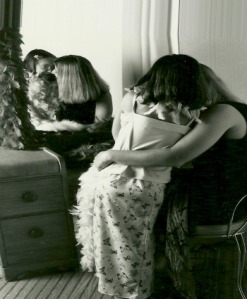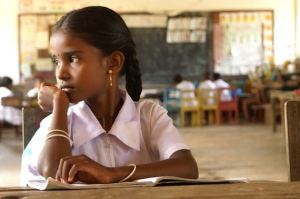![]() Research shows that educating girls in developing countries dramatically increases national literacy rates, which in turn, directly benefits economic development. When girls and women are provided equal education and economic opportunities, communities thrive.
Research shows that educating girls in developing countries dramatically increases national literacy rates, which in turn, directly benefits economic development. When girls and women are provided equal education and economic opportunities, communities thrive.
The United Nations has recognized the importance of promoting girls’ rights around the globe, and in 2011 announced October 11th as the “International Day of the Girl”. In response to this initiative, the nonprofit organization, Sage Girl, partnered with Rebecca Gaynier of iTwixie to create the IDG Summit. In anticipation of IDG 2014, I asked IDG Summit co-founder, Emily Bent, to provide us with some more information surrounding this upcoming global event and to give some suggestions on how all of us can get involved in helping raise awareness toward girls’ rights around the world. Feel free to read and share as often as you like!
Beyond Lipstick and Petticoats: First, Emily, tell us a little bit about the annual International Day of the Girl Summit: how and when was it founded, what is its mission, where is it held, and who is involved?
Emily: The IDG Summit was founded in the summer of 2012 in honor of the 1st International Day of the Girl on October 11, 2012. The UN declared October 11th as the ‘International Day of the Girl Child’ in December of 2011, and they marked Oct. 11, 2012 as the first commemoration of this day. Every year UNICEF declares a theme for IDG related to girls’ rights and concerns globally; this year, the theme is about eliminating violence against girls (here is the link to the announcement: http://www.unicef.org/gender/gender_66021.html).
The IDG Summit is a program and initiative supported by a local nonprofit organization, Sage Girl, which is based in Hunterdon County, NJ. We created the IDG Summit along with Rebecca Gaynier from iTwixie for a number of reasons. First, the IDG Summit celebrates the power and potential of girls globally. We look to the spirit of IDG to elevate the voices and experiences of girls, but also to inspire others to take action and to work together to change the world with and for girls. The IDG Summit also seeks to create partnerships amongst other girl-centered organizations and to raise awareness about the critical work that so many girls’ organizations are doing locally, nationally, and globally. Too often, we end up sectioned off from one another and don’t get the opportunity to collaborate or support one another – but the IDG Summit is all about collaboration and partnership. Each year, we partner with upwards of 50 – 60 organizations invested in girls’ rights and empowerment.
Our mission is simply to bring girls and girl-serving organizations together to celebrate IDG and to collectively elevate the status of girls globally. We do this primarily though social media and web-based technologies with several signature initiatives including: 11 Days of Action and IDG Webcast on Oct. 11th. These activities are held on our website, and social media pages. But, we also host a physical event at the United Nations called the Girls Speak Out (and this will be the 2nd year that we are organizing this event) which is an event that gives girls the chance to advocate on their behalf, address key issues and concerns in their everyday lives, and speak directly with members of the international community.
BLaP: What inspired you to create IDG?
Emily: Unfortunately, I cannot take credit for creating IDG – this was the international community, namely the United Nations that established IDG.
But in creating the IDG Summit, Rebecca and I were inspired by a number of things – the girls that we work with everyday, the amazing stories globally of girls taking action and becoming strong activists for the issues that impact their lives, the adults and organizations that tirelessly support girls and challenge others to see girls as peers and actors with something important to say and contribute to the world, and the global movement to not only recognize the possibilities that result from girls’ empowerment but also the call for solidarity and collaboration across borders. Our tagline is “Together, we are changing the world.” And we truly believe that if we can come together and leverage the energy and passion of IDG – we can change the world.
BLaP: Who are some of your major sponsors? In what ways have they contributed to your mission (i.e., UNICEF and this year’s theme: Ending the Cycle of Violence)?
Emily: Over the last several years, we have begun the process of identifying major sponsors for the IDG Summit. And while, we do not yet have a major sponsor – our partners involved in the 11 Days of Action, for example, contribute funds to help cover the costs associated with technology, program development, media-based support, and advertising. We are very lucky this year to have secured a signature sponsor for the Girls Speak Out; Janssen recognized the alignment of our missions and we are grateful for their support. The vast majority of our financial support comes from individuals, who are drawn to the cause and believe in the spirit of IDG, and our approach to engaging girls in this global movement.
Our mission is truly made real because of our IDG Summit partners and we could not put on the Girls Speak Out, 11 Days of Action, or IDG Webcast without their time, energy, and passion. A few of our key partners for these initiatives include (in no particular order): Coalition for Adolescent Girls, Working Group on Girls, Plan International’s Because I am a Girl Campaign, Alice Paul Institute, Bella Abzug Leadership Institute, Girls Learn International, SPARK Movement, Girls Coalition of Southwestern Pennsylvania, Women & Girls Foundation, I am a Girl Documentary, Teach a Girl to Lead, Pink Lemonade Stand Foundation, Girl Scouts of the USA, Intel and many others.
BLaP: Where do you see the movement headed over the next 5 years?
Emily: Over the next 5 years, I would expect the girls’ rights movement to continue to grow locally and globally. I think we will see an increase in the numbers of girls speaking out about issues in their communities, and bringing attention to how they advocate for change. I hope to see more collaboration amongst girl-centered organizations and also see more opportunities for girls to speak for themselves at high level, international, national and local events. In the spirit of IDG, I think it is critical that girls speak for girls and that they have the chance to advocate for their rights, and challenge the global injustices faced by girls daily.
BLaP: How can we help support your mission?
Emily: We invite everyone to join in any or all of our initiatives for IDG. Join the 11 Days of Action campaign which starts Oct. 1 – Oct. 11th on our website; everyday one of our partner organizations will organize an action for girls to take via social media to raise awareness about girls’ rights and power globally. Participate in the Oct. 11th Webcast, which includes a Twitter chat, Google Hangout, and film screening of Raising Ms President. Or come to the Girls Speak Out at the United Nations on October 10th – and if you can’t come in person, watch the event LIVE on our website at 3PM EST. We will also feature some of the performances on our website throughout the month of October.
Support our Indiegogo Campaign and help ensure that we can continue to bring girls’ voices to the United Nations, and engage girls through the IDG Summit signature initiatives. You can get an official IDG T-Shirt or join the 1st Global Girls Delegation for IDG! https://www.indiegogo.com/projects/international-day-of-the-girl-summit-idg2014
And of course, follow us on Facebook (www.facebook.com/DayoftheGirlSummit) or Twitter @IDG2014 to keep the conversation going about girls’ empowerment globally.
Thank you, Emily, for your time with this interview, as well as for all the work you do to continue helping girls around the world live a safer and more illustrious life. When girls thrive, the world thrives.
Please help support the conversation by sharing this information with all your friends and, as always, thanks for stopping by Beyond Lipstick and Petticoats!






